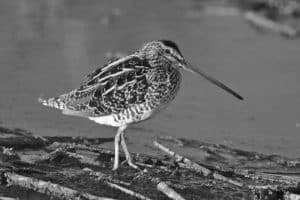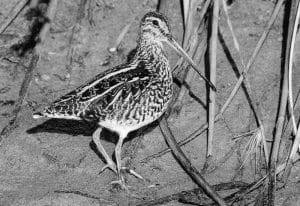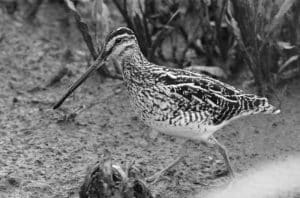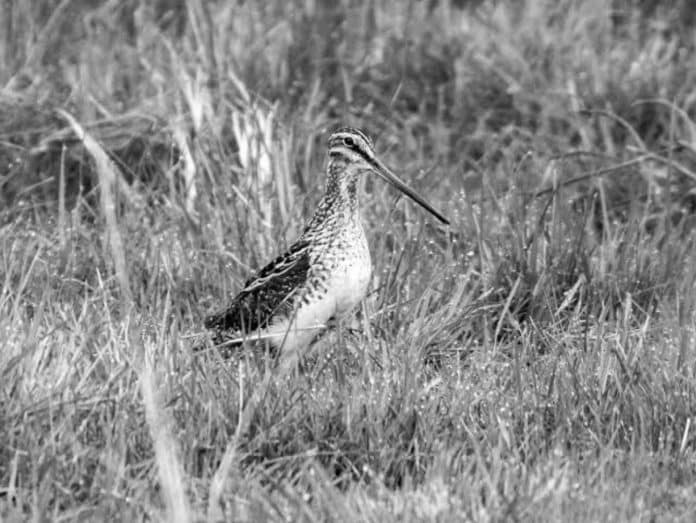Introduction to the African snipe in Tanzania
The African snipe is a fascinating bird species that can be found in the wetlands of Tanzania. These wetlands provide the perfect habitat for the snipe, allowing them to thrive in their natural environment. In this article, we will explore the habitat and distribution of the African snipe, as well as its physical characteristics and behavior. We will also delve into its breeding and nesting habits, migration patterns, and the threats it faces. Additionally, we will uncover interesting facts and folklore about the African snipe in Tanzania, and provide bird-watching locations in Tanzania where you can spot this elusive bird. So, grab your binoculars and get ready for an adventure into the world of the African snipe!
Habitat and distribution of the African snipe

The African snipe is primarily found in the wetlands of Tanzania, which are abundant in shallow water, marshes, and swamps. These wetlands provide the snipe with the ideal habitat for foraging and nesting. The snipe is well adapted to this environment, with its long bill that allows it to probe the soft mud for invertebrates, its main source of food. The wetlands of Tanzania offer a diverse range of vegetation, from reeds to grasses, providing the snipe with ample cover and nesting opportunities.
The distribution of the African snipe in Tanzania is widespread, with sightings reported in various regions across the country. Some of the key areas where the snipe can be found include the Selous Game Reserve, the Serengeti National Park, and the Ngorongoro Conservation Area. These protected areas not only provide a safe haven for the snipe but also attract birdwatchers and nature enthusiasts from around the world.
Physical characteristics and behavior of the African snipe
The African snipe is a medium-sized bird, measuring around 25 centimeters in length. It has a mottled brown plumage, which provides excellent camouflage in its wetland habitat. One of the most distinctive features of the snipe is its long bill, which is flexible and sensitive, enabling it to capture small invertebrates buried in the mud.
In terms of behavior, the African snipe is a solitary bird, preferring to forage alone rather than in groups. It is primarily active during the twilight hours, known as crepuscular. This behavior allows the snipe to avoid predators while taking advantage of the abundance of prey during this time. The snipe’s flight is also a sight to behold, as it performs a unique display known as “winnowing.” During winnowing, the snipe flies in a zigzag pattern, producing a distinctive sound by vibrating its outer tail feathers. This display is believed to be a courtship ritual, used to attract mates and establish territories.
Breeding and nesting habits of the African snipe
The breeding season for the African snipe in Tanzania typically begins in the rainy months, when the wetlands are at their peak. During this time, male snipes engage in aerial displays to attract females. These displays involve impressive flight maneuvers, such as steep dives and sudden changes in direction. Once a pair is formed, the male and female work together to build a nest on the ground, usually hidden among tall grasses or reeds.
The nest of the African snipe is a shallow depression lined with grass and leaves. The female typically lays a clutch of four eggs, which are incubated by both parents for a period of around three weeks. Once the eggs hatch, the parents take turns feeding the chicks, regurgitating small invertebrates to provide them with nourishment. The chicks grow rapidly and are capable of flight within a few weeks. After the breeding season, the African snipe and its offspring may migrate to different wetland areas in search of food and suitable habitat.
Migration patterns of the African snipe

The African snipe is known for its impressive migration patterns, as it travels vast distances in search of suitable wetland habitats. During the non-breeding season, snipes from Tanzania may migrate to other parts of Africa, such as Kenya, Uganda, and Ethiopia. Some individuals have even been recorded traveling as far as Europe and Asia.
The migration of the African snipe is influenced by factors such as food availability and weather conditions. As wetlands dry up during the dry season, snipes are forced to move to areas with more water and abundant food sources. They navigate using a combination of visual cues, celestial navigation, and their innate sense of direction. The migration of the snipe is truly a remarkable feat, highlighting the importance of preserving wetlands along their migration routes.
Threats and conservation efforts for the African snipe
Despite their adaptability and impressive migration abilities, the African snipe faces numerous threats to its survival. One of the main threats is habitat loss due to human activities such as agriculture, urbanization, and drainage of wetlands for development. The conversion of wetlands into farmland or industrial areas disrupts the snipe’s natural habitat and reduces the availability of food and nesting sites.
Another significant threat to the African snipe is hunting, both legal and illegal. In some regions, snipes are hunted for sport or for their meat. This unsustainable hunting pressure can have a detrimental impact on snipe populations, especially during the breeding season when they are most vulnerable.
To combat these threats, conservation efforts are underway in Tanzania and other countries where the African snipe is found. These efforts include the establishment of protected areas, the implementation of sustainable agricultural practices, and the enforcement of hunting regulations. By raising awareness about the importance of wetlands and the conservation of the African snipe, we can ensure the long-term survival of this remarkable bird species.
Interesting facts and folklore about the African snipe
The African snipe has captivated the imagination of people for centuries, leading to the creation of various interesting facts and folklore surrounding the bird. One popular belief is that the snipe is an elusive and difficult bird to spot, hence the phrase “snipe hunting” to describe a futile or impossible task. In reality, the snipe is not impossible to find, but its camouflage and crepuscular behavior make it a challenge for even the most experienced birdwatchers.
Another interesting fact about the African snipe is its ability to produce a drumming sound with its wings during courtship displays. This sound is created by the air rushing through the snipe’s specialized outer tail feathers, creating a unique acoustic effect. The drumming sound is believed to attract mates and establish territories.
In folklore, the African snipe is often associated with rain and wetlands. In some cultures, the snipe is considered a symbol of good fortune and is believed to bring rain when it calls. Its presence in the wetlands is seen as a sign of a bountiful harvest and a healthy ecosystem. These folklore traditions highlight the close connection between the snipe and its habitat, emphasizing the importance of wetland conservation.
Bird-watching locations in Tanzania for spotting the African snipe
If you’re an avid birdwatcher and eager to spot the African snipe in Tanzania, there are several bird-watching locations that offer excellent opportunities for sightings. The Selous Game Reserve, located in southern Tanzania, is one such destination. With its vast wetlands and diverse birdlife, the reserve is a haven for the African snipe and many other water bird species.
Another fantastic location is the Serengeti National Park, famous for its annual wildebeest migration. The park’s wetland areas attract a wide variety of bird species, including the African snipe. The Ngorongoro Conservation Area, with its crater lakes and marshes, is also an ideal spot for birdwatching and snipe sightings.
When visiting these locations, it’s essential to be patient and observant. The African snipe’s crepuscular behavior means that your best chances of spotting one are during the early morning or evening hours. Be sure to bring your binoculars and a field guide to help you identify the snipe and other bird species you may encounter. Remember to respect the birds and their natural habitat by maintaining a safe distance and avoiding any disturbance.
Photography tips for capturing the African snipe in its natural habitat
If you’re a photography enthusiast, capturing the African snipe in its natural habitat can be a rewarding challenge. Here are some tips to help you get that perfect shot:
- Be patient and observant: The African snipe is known for its elusive nature, so it’s important to spend time observing its behavior and movements. Look for signs such as winnowing displays or feeding activity, which can indicate the presence of a snipe nearby.
- Use camouflage and stay hidden: The snipe’s excellent camouflage makes it difficult to spot, so it’s important to blend in with your surroundings. Wear neutral-colored clothing and avoid sudden movements that may startle the bird.
- Stay low and use natural cover: Position yourself at ground level to capture the snipe from its eye level. Utilize natural cover such as tall grasses or reeds to hide your presence and create a more intimate composition.
- Use a longer focal length: The African snipe is a relatively small bird, so using a longer focal length lens will allow you to capture more detail without disturbing the bird. A telephoto lens in the range of 200-400mm is recommended.
- Capture the snipe in action: Try to capture the snipe’s unique behaviors, such as winnowing displays or foraging in the mud. These actions add interest and tell a story in your photographs.
Remember to always prioritize the well-being of the bird and its environment. Avoid any actions that may disturb the snipe or its habitat, and adhere to ethical photography practices.
Conclusion and the importance of preserving the wetlands for the African snipe

The African snipe is a remarkable bird species that calls the wetlands of Tanzania its home. Throughout this article, we have explored its habitat and distribution, physical characteristics and behavior, breeding and nesting habits, migration patterns, threats it faces, interesting facts and folklore, bird-watching locations, and photography tips. It is clear that the African snipe is an integral part of the wetland ecosystem and plays a crucial role in maintaining the balance of nature.
Preserving the wetlands of Tanzania is not only important for the survival of the African snipe but also for countless other bird species and wildlife that rely on these habitats. By protecting wetlands from habitat loss, promoting sustainable practices, and raising awareness about the importance of conservation, we can ensure that future generations will have the opportunity to witness the beauty of the African snipe and the wonders of the wetlands.
So, the next time you find yourself near the wetlands of Tanzania, take a moment to appreciate the incredible diversity of birdlife that thrives within. Listen for the drumming sound of the African snipe’s wings, watch as it performs its mesmerizing winnowing display, and remember the importance of preserving these wetlands for the snipe and all the other creatures that call them home. Together, we can make a difference and ensure a brighter future for the African snipe in Tanzania and beyond.


































